How to Create a High-Converting Content Strategy (Proven Examples + Tools)
Imagine this: you’ve poured countless hours and resources into creating content, writing article after article, and investing in content marketing.
Yet, despite your efforts, you’re left frustrated with the lack of conversions. Not even a single article seems to drive the results you’re hoping for.
I know, it’s a familiar struggle for many businesses.
In this article, I will share my experiences creating high converting content that captures your audience’s attention and drives conversions.
Let’s start now!
What is High-Converting Content?
High-converting content is like a magnetic force that captivates your audience, draws them in, and compels them to take action.
It’s the kind of content that doesn’t just passively exist on your website or social media feed. It engages and resonates with your target audience, igniting their curiosity, sparking their emotions, and addressing their pain points.
Why High-Converting Content Instead of Highly Rankable Content?
You might even ask: Is there any difference between these two terms?
Let’s investigate this based on one example from our clients.
Previously, we have helped one of our clients rank on the first page of Google SERP consistently for various bottom-of-the-funnel (BOFU) keywords (these are category keywords):
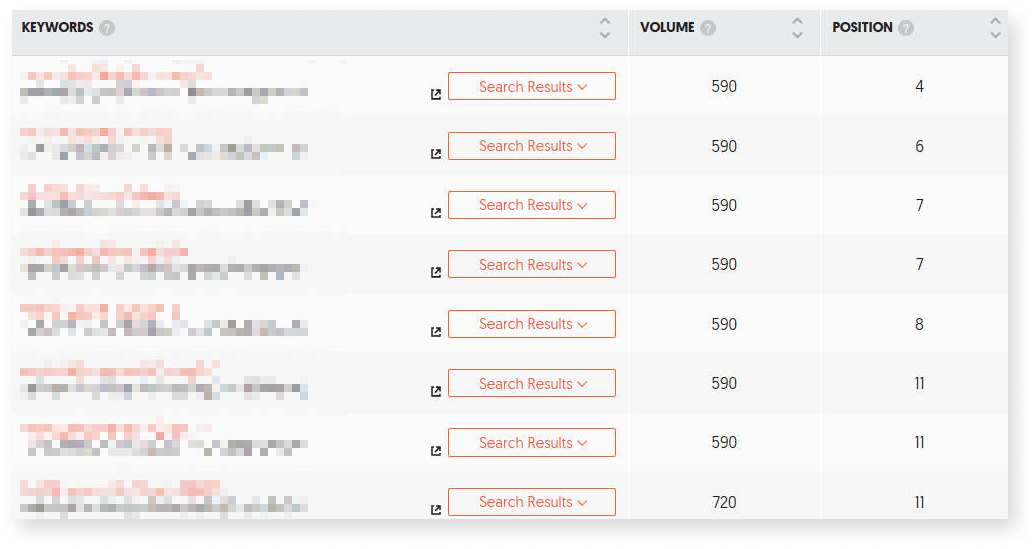
And these keywords have a high search volume per month:

But sadly, we didn’t get many conversions for this piece of content.
However, after we improved the content from a conversion perspective, the improvement was huge:
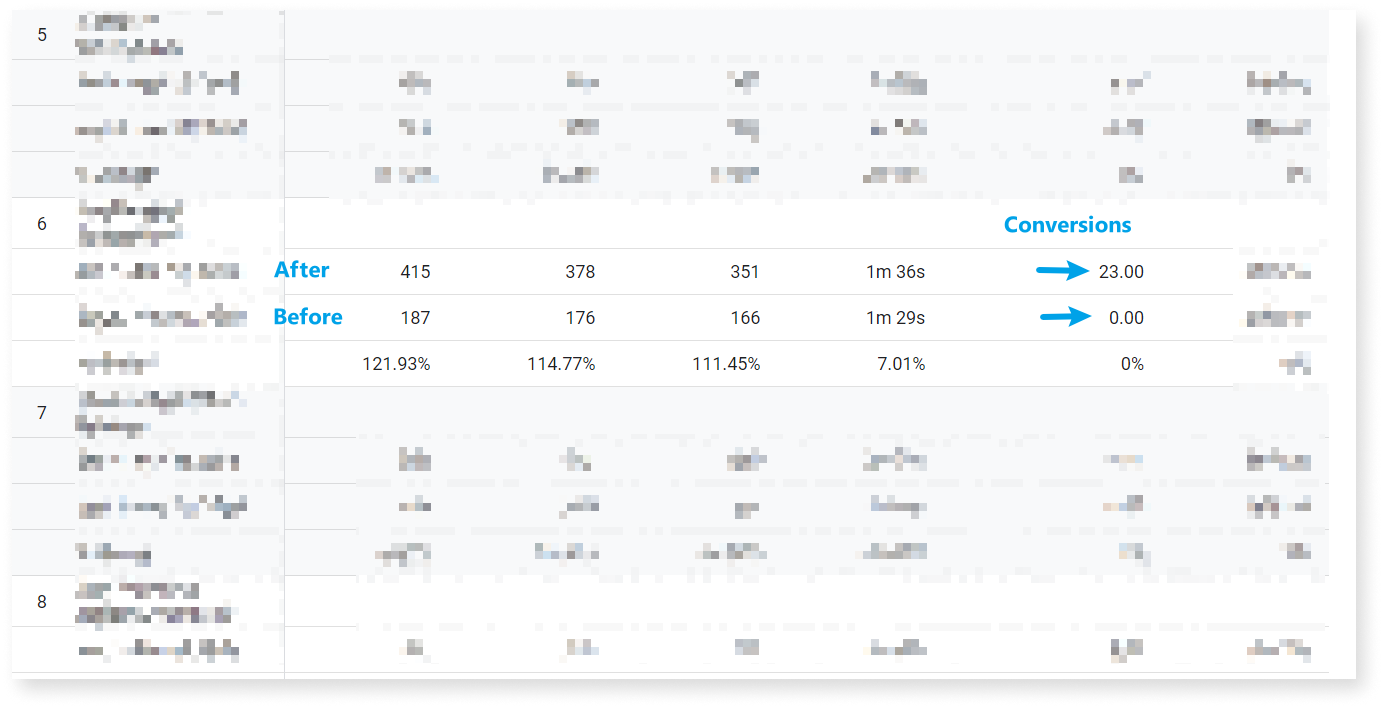
See that a change in the content direction leads to a huge difference!
I have to clarify that I’m not saying we should ignore highly rankable content but rather combine these goals.
In short, our goal should be creating content that not only just ranks at the top of Google SERPs, but also generate conversion. We want our content to convince our target audience to take certain actions we want, be it signing up for an email newsletter or filling up contact forms.
How to Create a Content Strategy that Drives Conversion?
Let’s take a look at the process of creating high-converting content.
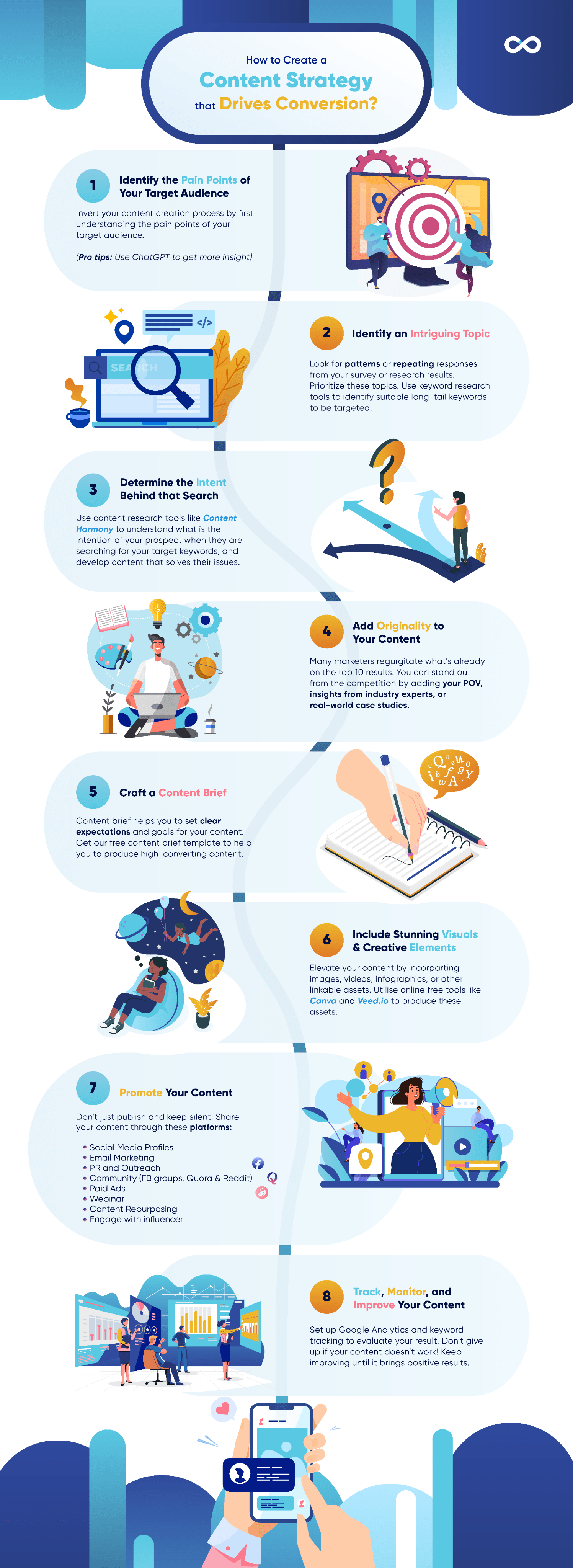
Note: Feel free to share this infographic! Click here to download.
Identify the Pain Point of Your Target Audience
Before creating content, we usually use a keyword-centric approach, where we start by inserting a related topic in our keyword research tool and identify which keywords have a high volume with low keyword difficulty.
However, the main problem with this approach is that the topic you pick might not have a great conversion intent. You might rank easily for that keyword, but it doesn’t bring new leads.
While some keyword research tools like Semrush can reveal the search intent of the keyword you’re targeting, you might not able to convince your visitors unless you truly address and solve their pain points.
Pain points are crucial in marketing and content creation because they address the needs, challenges, and problems that your target audience is experiencing.
When you understand the gaps or issues your audience wants to solve or alleviate, you can tap into these pain points and create a powerful emotional connection with your audience.
Therefore, a better way to create high-converting content is first to identify their pain points. But how to understand my target audience better?
Conduct Surveys or Interviews
The most straightforward way is to conduct surveys or interviews. At VeecoTech, we’ll meet with our clients and ask them several questions based on our checklist. However, here are a few questions:
- What issue or challenge were you trying to address before discovering our product or service?
- If our product/service was unavailable, what other product or service would you consider an alternative?
- What are the three key advantages or benefits you experience from using our product or service?
- How would you explain our product or service to a friend without prior knowledge about us?
- If you were to search online for information about our product or service, what keywords or phrases would you use in your research?
If your customers are unavailable for physical or virtual meetups, create a survey form and send it to them through email or social media. You can also consider giving them some surprise gifts to encourage them to help you fill up the survey.
Consume Top Content from Industry Experts
Sometimes, we might face a situation of not getting enough information from our survey or interviews, especially when we want to create content for certain topics that we don’t know much about.
To solve this issue, Tommy Walker, founder of The Content Studio, mentioned that he consumes as much content from the experts in the field as possible to get a big picture of his client’s position in that particular industry.
But when it comes to creating the content, many conversations with clients will continue to understand their perspectives on the topic he will write about.
Identify an Intriguing Topic
As we have limited time and resources, creating content for all topics related to your business is impossible. Hence, you need to prioritise topics that you can both rank and generate conversion.
Here are a few ways to identify a suitable topic to create content:
Look for Patterns or Repeating Responses
If you’re able to interview more than one of your clients, you should be able to identify some similar traits from their responses. This a great indicator that you should probably prioritise this topic.
For instance, if you’re a SaaS company that sells project management products, and you notice that most of your target audience will choose Asana or ClickUp when your service is not available, then you might need to consider developing a comparison content (X vs Y) that highlight your product’s unique points.
Use Frequent Responses for Keyword Research
Once you have identified the topic you want to prioritise, use that topic to conduct keyword research.
You can use various paid tools like Ubersuggest and Semrush to identify more related, long-tail keywords to include in your content. Simply insert your topic into the tool, then identify what related keywords you can use in your content.
For instance, your research found that “project management tools” is a good topic to explore. Then, insert it in the tools to get more keyword ideas.

You can also analyse the top organic keywords that rank by the first five pages on Google by placing their URL in your keyword research tool.
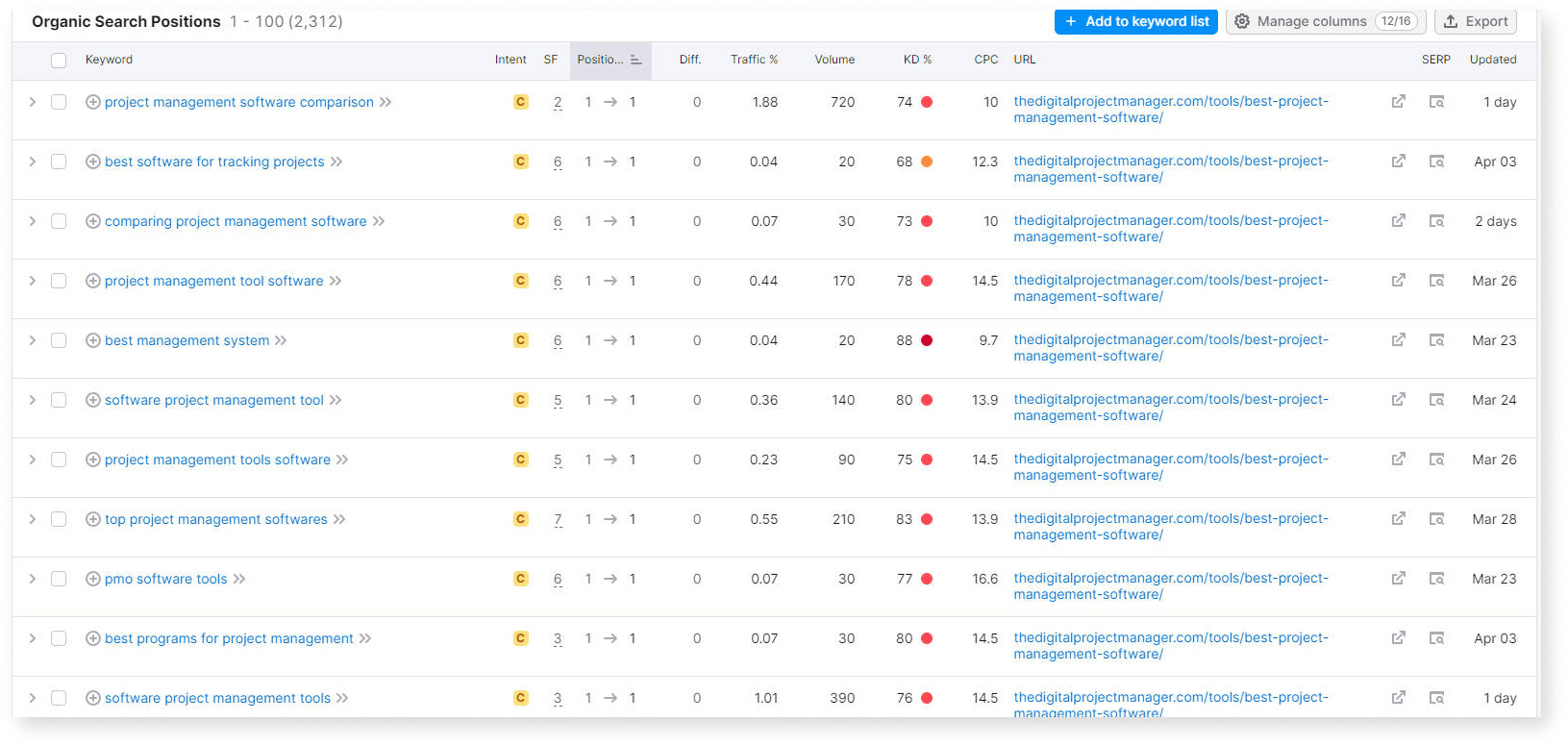
If these tools are unavailable, you can install Keyword Everywhere Chrome Extension to help you identify more long-tail keywords.
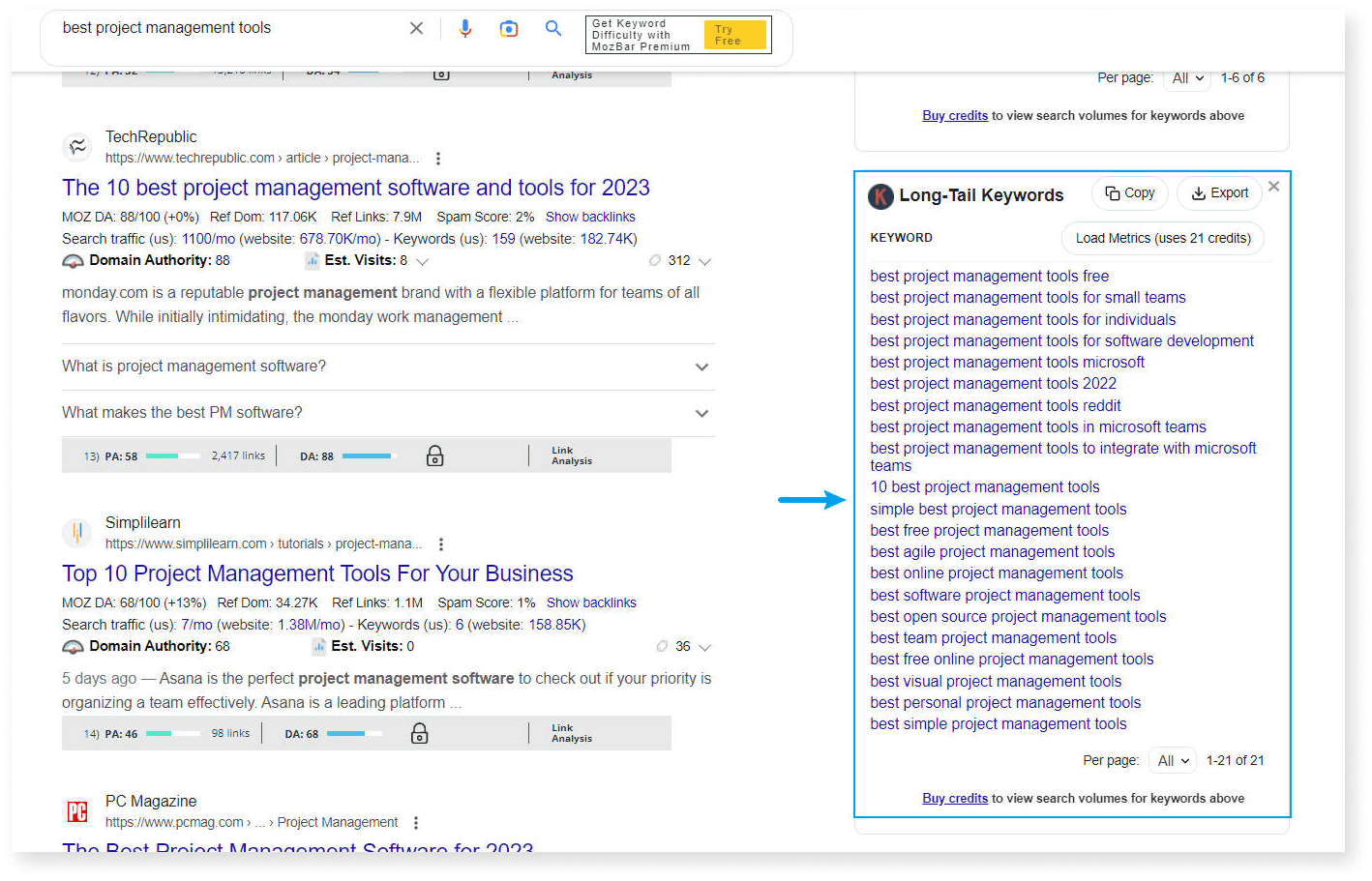 Don’t forget to take a look at the People Also Ask and Related Searches sections. You can collect all the insights you found and place them in a Google Doc or Google Sheet.
Don’t forget to take a look at the People Also Ask and Related Searches sections. You can collect all the insights you found and place them in a Google Doc or Google Sheet.
Use ChatGPT to Get More Insights
If you still cannot draw any insights from your research results, don’t forget to ask ChatGPT to help you.
You can prompt ChatGPT by asking it to think from a customer perspective. Ask ChatGPT to provide you with the reasons people are searching for this term.
For instance, I gave ChatGPT a job title and company size and asked it to provide the possible reasons and circumstances behind the search.
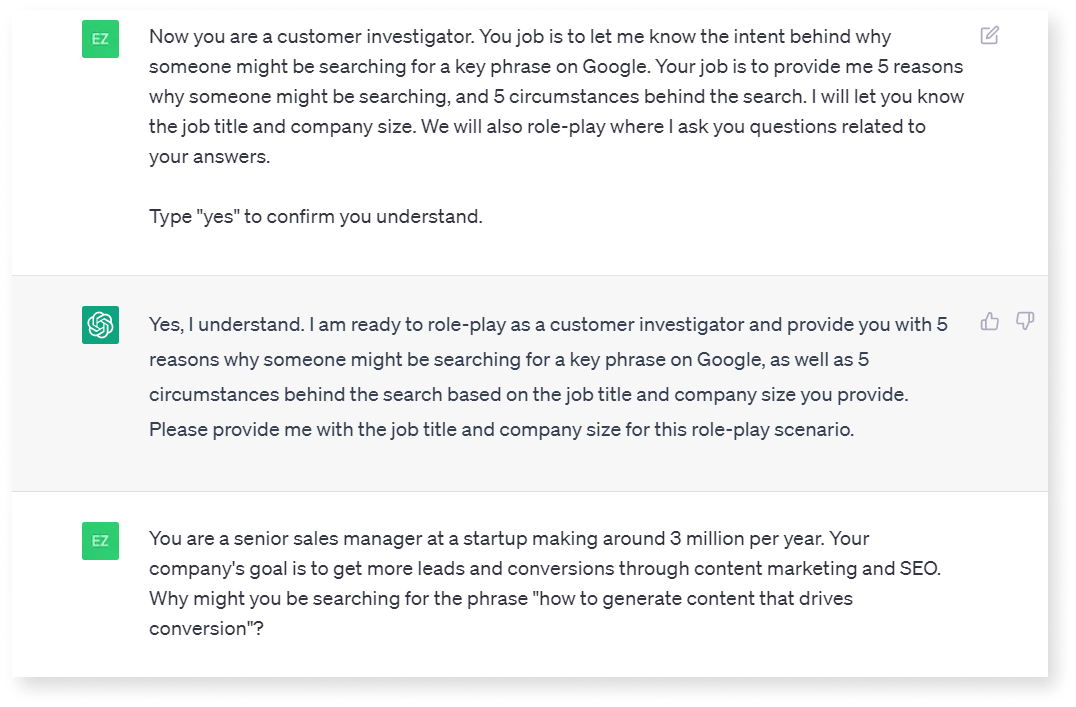
And here’s the results:
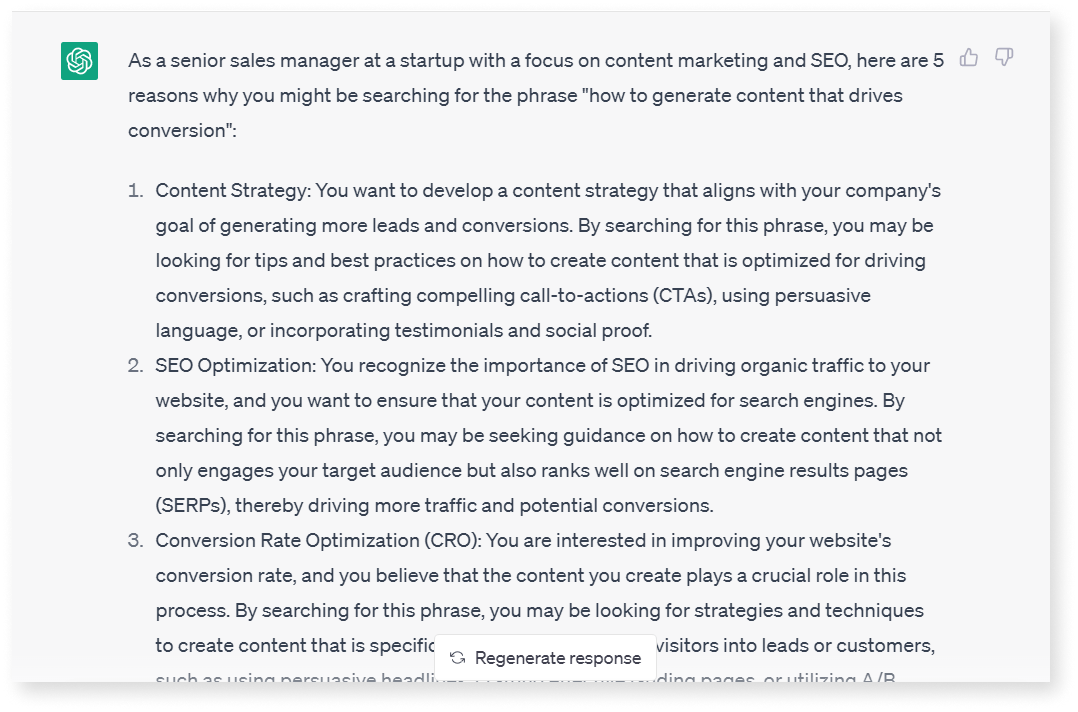
Awesome right?
Determine the Intent Behind that Search
Dave Davies, Co-founder of Beanstalk Internet Marketing, once said, “Content is what the search engines use to fulfil user intent.” Since Google incorporates RankBrain into its algorithm, your ranking will drop if your content cannot meet the search intent.
Understanding the intent behind a search is like unlocking the secret code to your target audience’s needs and motivations. It’s crucial to decipher the underlying purpose of a search query to ensure your content aligns with your audience’s needs.
However, it’s not easy to identify the search intent. You can’t hope to rank by identifying the type of search intent and placing your target keywords in your content.
So how do you analyse the search intent effectively? I highly recommend a content research tool, Content Harmony. It’s a powerful and comprehensive tool that streamlines the content creation process.
You can 10X your search intent research process just with this tool. Here are some of its features:
- An overview analytics of the topic – Search volume, primary intent, average word count, content difficulty, rank difficulty, and domain difficulty
- Search intent and a brief explanation of the intent
- SERP freshness analysis that helps you to identify whether Google prefers to rank fresh content for this term
- Overlapping keywords for the top 10 results
- Content outline analysis for the top 10 results
- Questions analysis from Quora, Reddit, etc. related to your topic
- Your website internal link suggestions and potential external links
- SERP analysis that shows the domain authority, referring domains, estimated traffic and content score
- Image and video analysis that shows the type of visual assets that your competitors are using
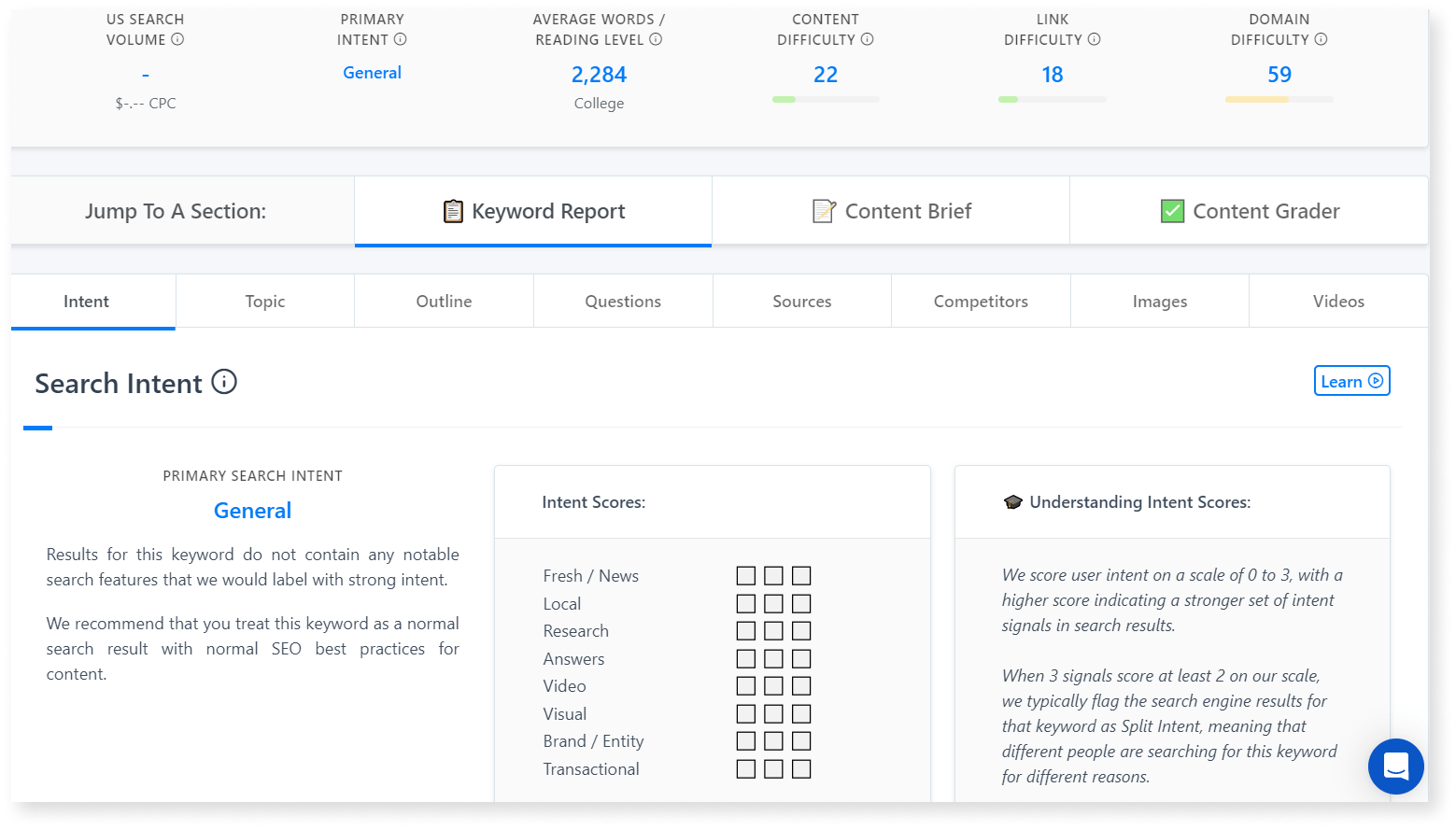
Although the tool is packed with awesome features, you can get lost if you’re not sure what information is necessary to collect. Here are some insights you should take note of:
- Primary Intent of this term, then optimize your content based on the intent.
- SERP freshness. You can use it as a guide to understanding how long you need to rank.
- Explore more questions that are related to this term. See if you can cover their queries in your content (You can also save the queries and promote your content there once it’s live)
- Discover their internal and external links. Content Harmony will show other pages on your website that you can link to so you can keep your visitors engaged with your content. You can also check the external links you can link to or get backlinks.
- Check the number and type of images & videos used in the top 10 results. Use this as a reference before you proceed to create creative elements.
Add Originality to Your Content
If you’re a content marketer, you probably know what a “Google SERP research paper”, where you create content by regurgitating the topics already covered in the top 10 SERP results is.
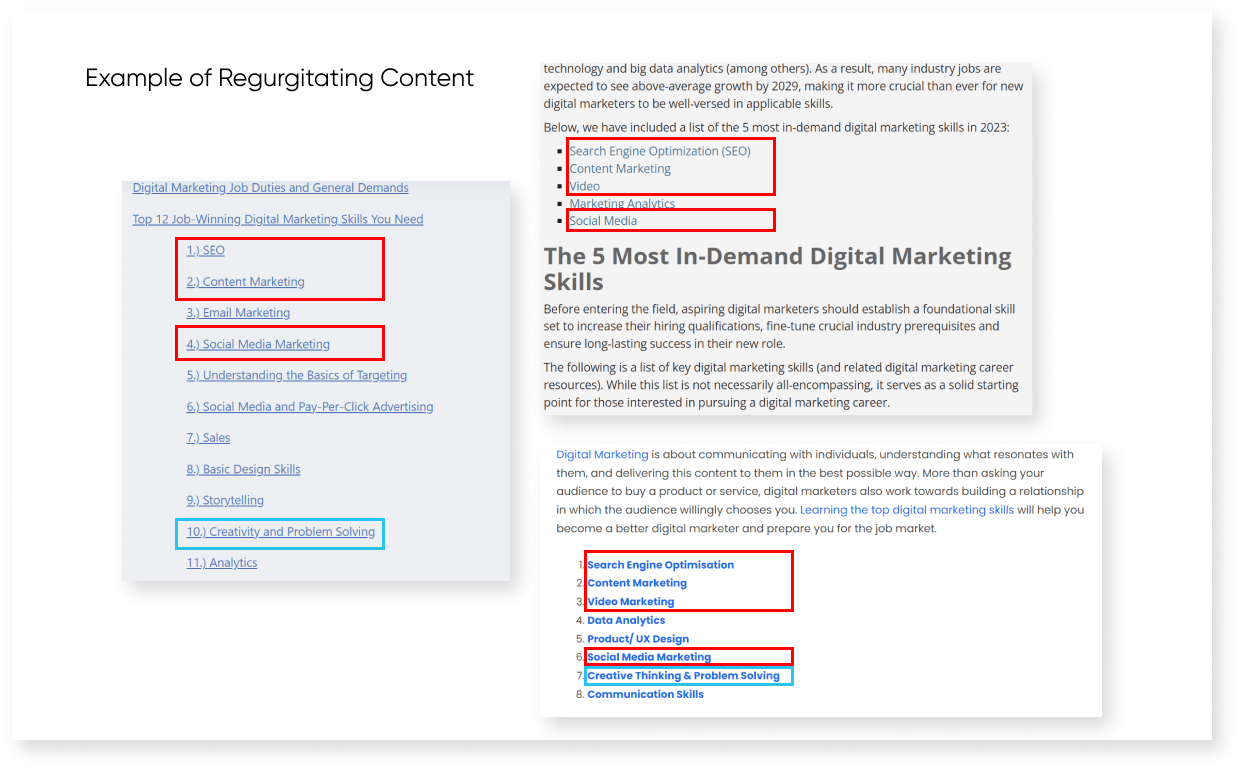
It’s not saying that this is wrong, but what’s so special or unique about your content if you’re doing a summary report?
So how can you make your content unique especially if your top-ranking competitors already published comprehensive content?
Determine the Content Gap
Go through the top 10 results and find out what is lacking. When I was preparing content about the reason to build a website, I found that most of the ranked content did not provide examples for each of the points they mentioned.
Hence, I think it will add more value to the readers if I include proof of how websites have helped our clients improve their businesses. For example, you can explore how dentistry benefits from SEO to see real case studies demonstrating SEO’s impact in a specific industry.
Ask yourself, can I speak from an unique angle or add any unique elements to your content?
By featuring appropriate examples in the content, our content is ranked on the first page of Google.
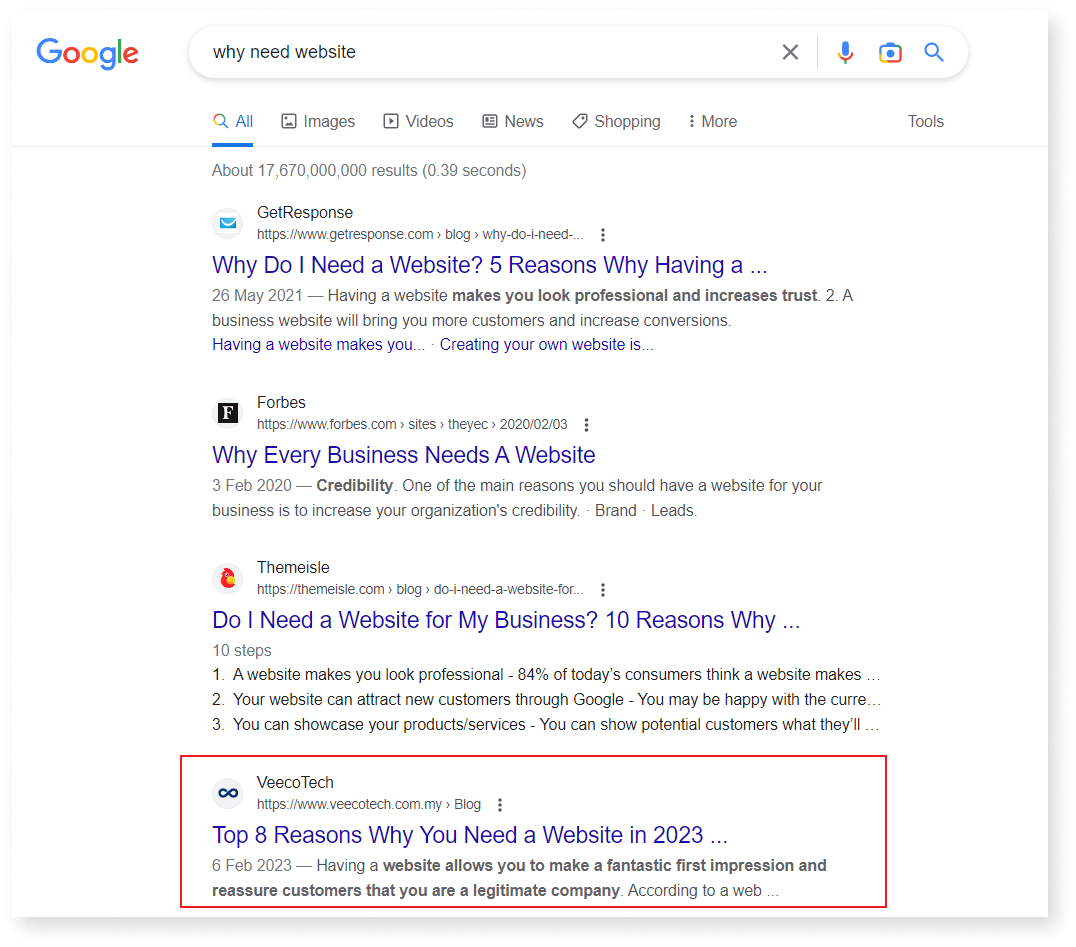
Ask Experts in Your Industry
Include thoughts or opinions from experts to help your content stand out, because it is tedious, and most people don’t want to spend time on it.
I’m not saying that by adding a few quotes from your industry leaders, you can make your content become highly converting. You should get in touch with the expert and invite him to share insights or advices that could help your target audiences.
You can even go further by asking them if they are willing to share real case studies or experiences related to your topic.
If you’re preparing content for your clients, there is a high possibility that they are more familiar in that topic compared to yourself. So why not ask them instead of cracking your head trying to figure out something that you don’t even familiar?
Speaking of experts, at VeecoTech, we offer tailored SEO services in Malaysia to help brands of all sizes increase visibility, drive leads, and grow sustainably. If you’re curious about SEO price in Malaysia, contact us today to learn how we can customize a strategy just for you.
Turn Searches into Sales Everywhere They Happen
When prospects Google your products, check the Map Pack, or fire questions at ChatGPT, Gemini, or Perplexity, will they meet you or your rival?
Our RankRise Growth Plan blends battle-tested SEO with AI-research optimisation, delivering an averaged +176% lift in organic traffic within 90 days for Malaysian SMEs.
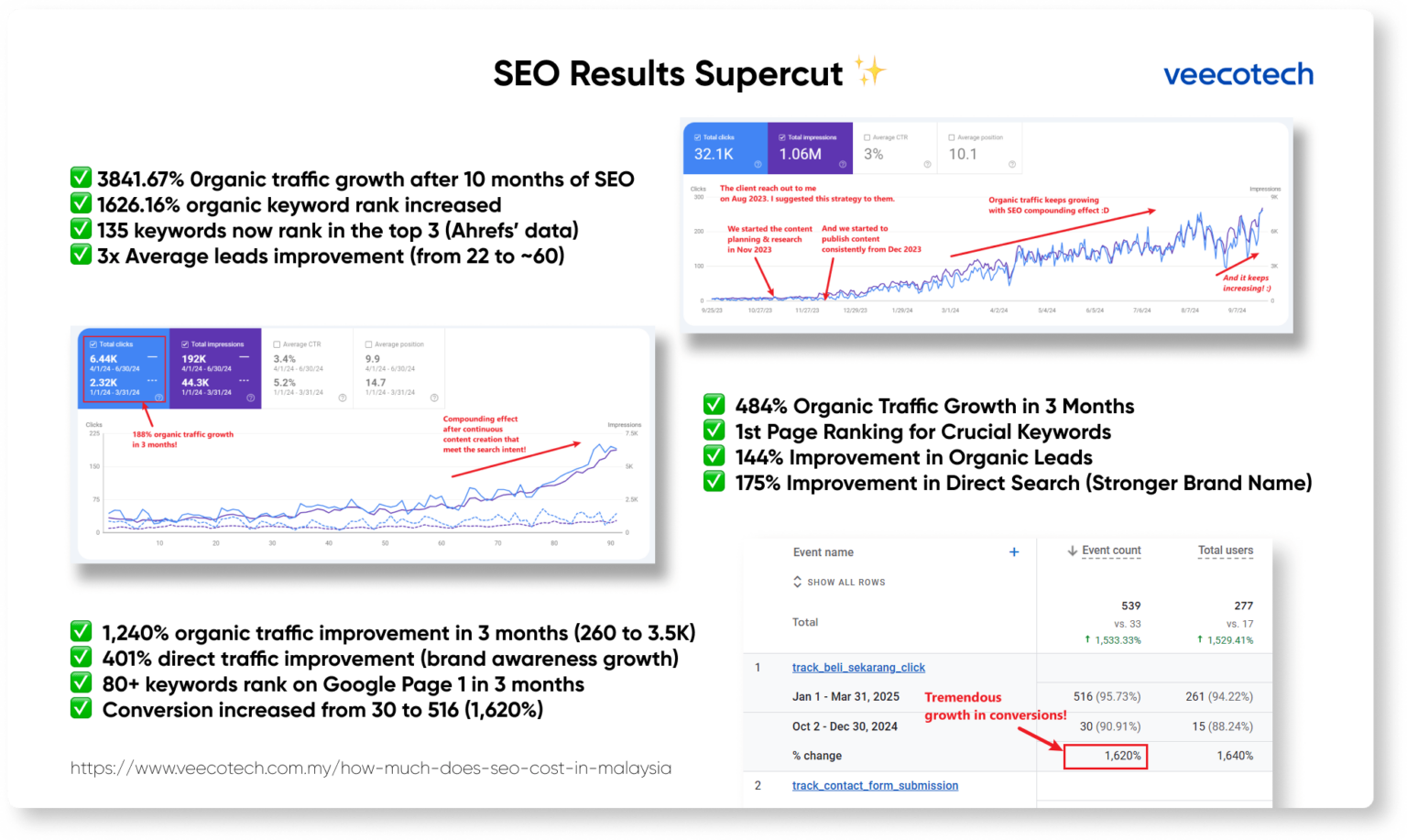
If you’re serious about:
- ✅ Multiplying your traffic & conversions across Google, Bing, AI Chatbots and organic socials
- ✅ Get hands-off execution by senior strategists—free up your team’s time
- ✅ Building revenue-driving assets that keep selling long after we hit "publish"
Then the RankRise Growth Plan could be your best next step.
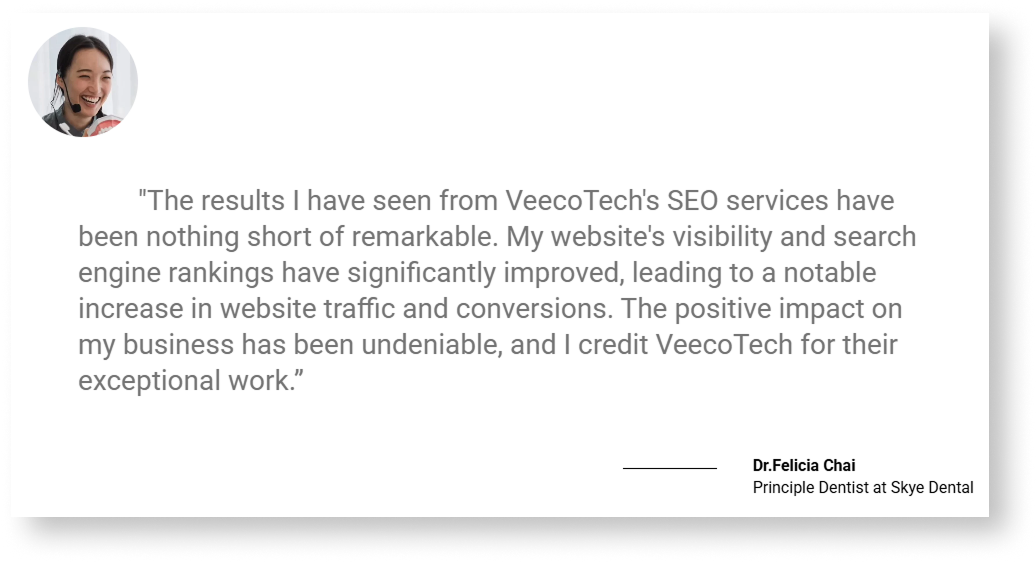
Just start from RM 2,899/month!
And if you don’t see measurable gains in traffic and visibility within 90 days, we refund every cent. No fine print.
👉 Book your free 15-min strategy call and walk away with a tailored competitive teardown—whether we work together or not.
Share Something from Your Point of View
Your style and solution for solving an issue might differ from your competitors even though you are in the same industry. You can always share something from the perspective of “how we do it in our way”.
For instance, you can agree with the solutions provided by the majority with your experience or previous research. You can also disagree with it by mentioning your reasoning.
Craft a Content Brief
Although it’s not a must to have a content brief before you prepare your content, it’s really helpful, especially if you outsource your content writing task to a copywriter.
A great content brief helps you set clear expectations and goals for your content and understand the important data for targeting this topic, such as the average word count, average referring domains and search traffic.
In fact, Content Harmony can help you to generate a content brief based on the topic you have researched previously. It even incorporates an AI assistant to help you generate a unique brief.
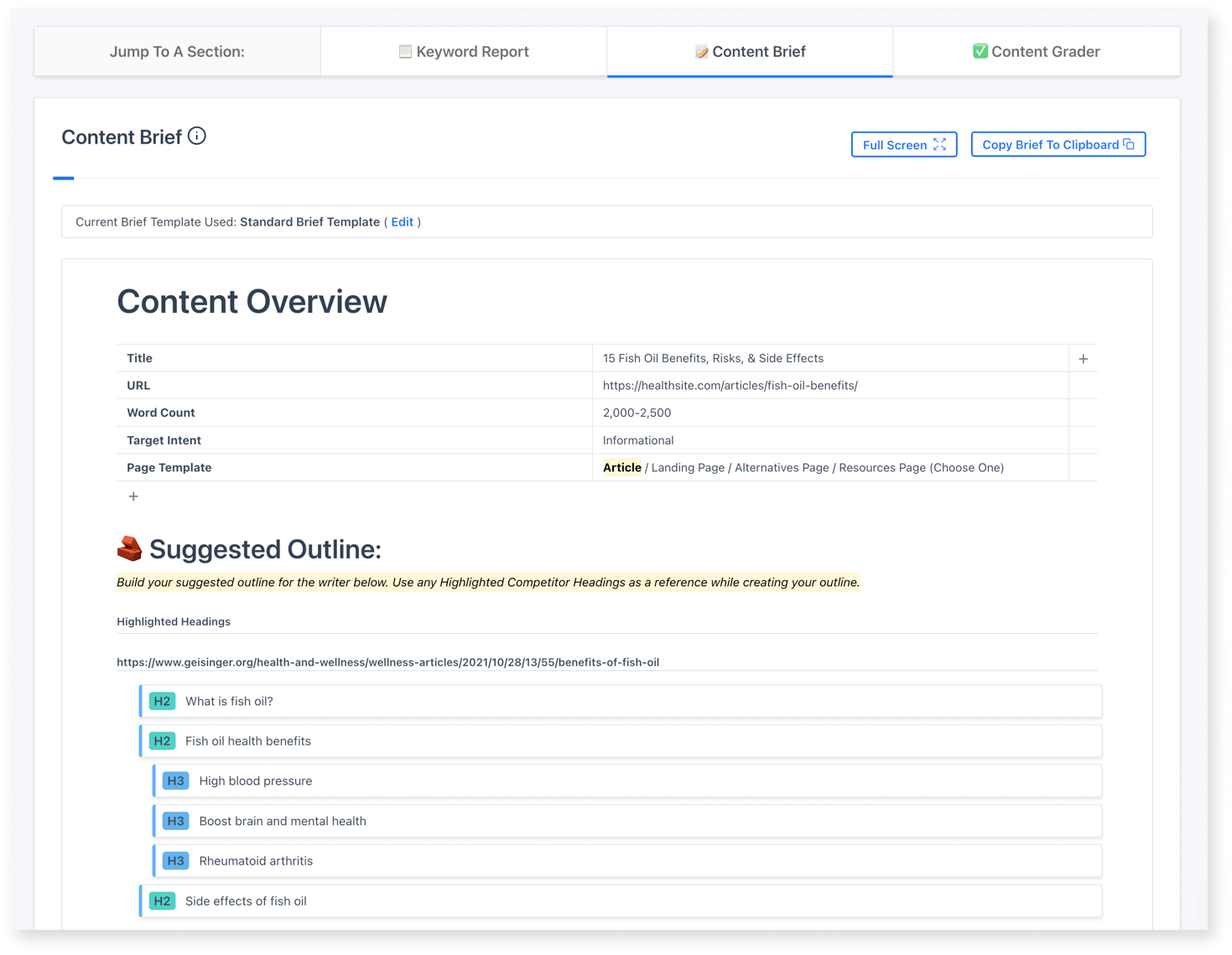
Another advantage of using Content Harmony is you can check how your content performs by using the Content Grader tool. Then, you can optimize your content based on the suggestions.
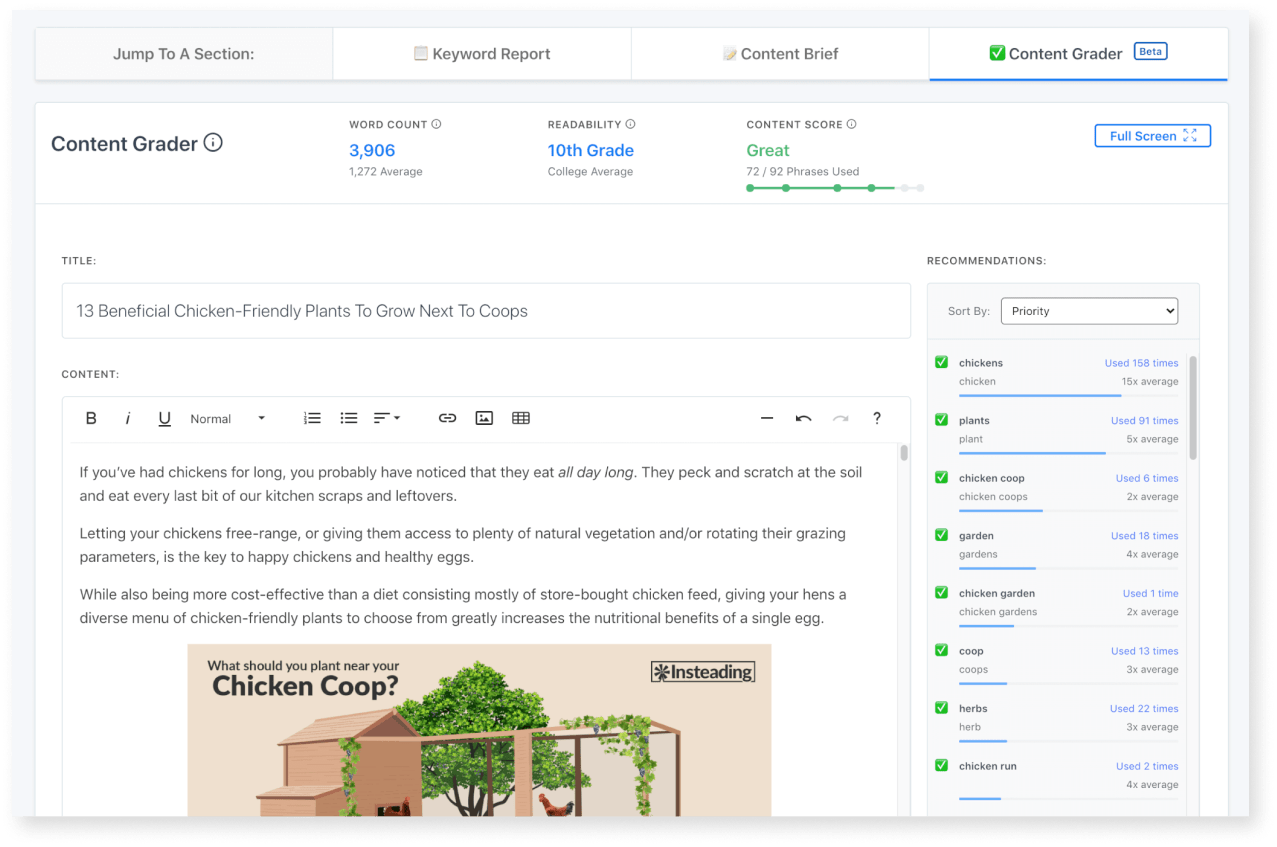
Here are some details you should include in your brief:
- Content objective (based on the pain point)
- Target audience
- Focus topic & keyword
- Intent
- Headline and meta description
- SERP overview – outline of competitor’s content, average word count, average link requires, etc
- Final outline of your content (with heading tags and a brief description for the paragraph)
- Visuals to be added (more about this in a sec)
- Call to action
I’ll create another article on the details of writing the content (so stay tuned!). Anyway, if you’re not considering getting the tool, you can get a free content brief template we use.
Include Stunning Visuals & Creative Elements
Nobody likes to read wordy content. So add visuals such as images, charts, infographics and etc, to make your content attractive.
Sometimes, adding humour elements such as GIFs, memes, or funny-yet-related comics helps to improve content sharing. Research from UCLA found that humans are more likely to share entertaining, useful or interesting content.
There are a handful of free GIF makers and meme makers you can use to try out.
Another great way to keep creating content that resonates with your audience and encourages them to share it with others is using video.

While it’s not a must to include video in all your content, research conducted by Wzyowl found that 90% of their respondents found that video marketing helped them to generate leads, and 87% of marketers say video has directly helped to increase sales.
I found it very handful to create videos using the VEED video editor. In addition to its user-friendly video editing interface and wide selection of ready-made templates, one standout feature I love about VEED is the text-to-speech functionality.
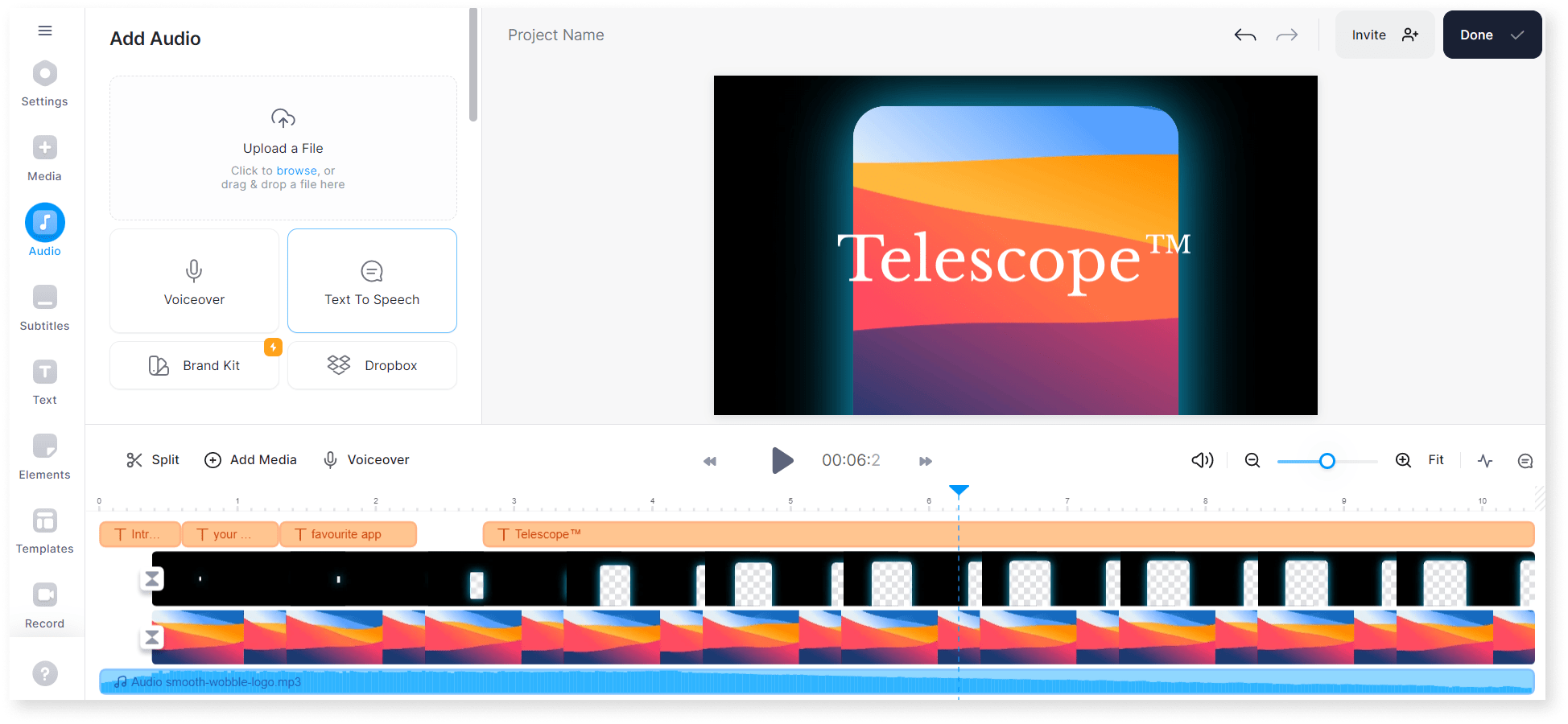 This handy feature saves you time by automatically generating voiceovers for your videos, eliminating the need for manual editing. It’s a convenient and efficient way to add professional narration to your videos without the hassle of recording and editing voiceovers separately.
This handy feature saves you time by automatically generating voiceovers for your videos, eliminating the need for manual editing. It’s a convenient and efficient way to add professional narration to your videos without the hassle of recording and editing voiceovers separately.
Another great feature is its AI online transcription with translation ability. This is especially helpful for SEO as you can repurpose your podcast or webinar content into blog posts, which helps you to save tons of precious time.
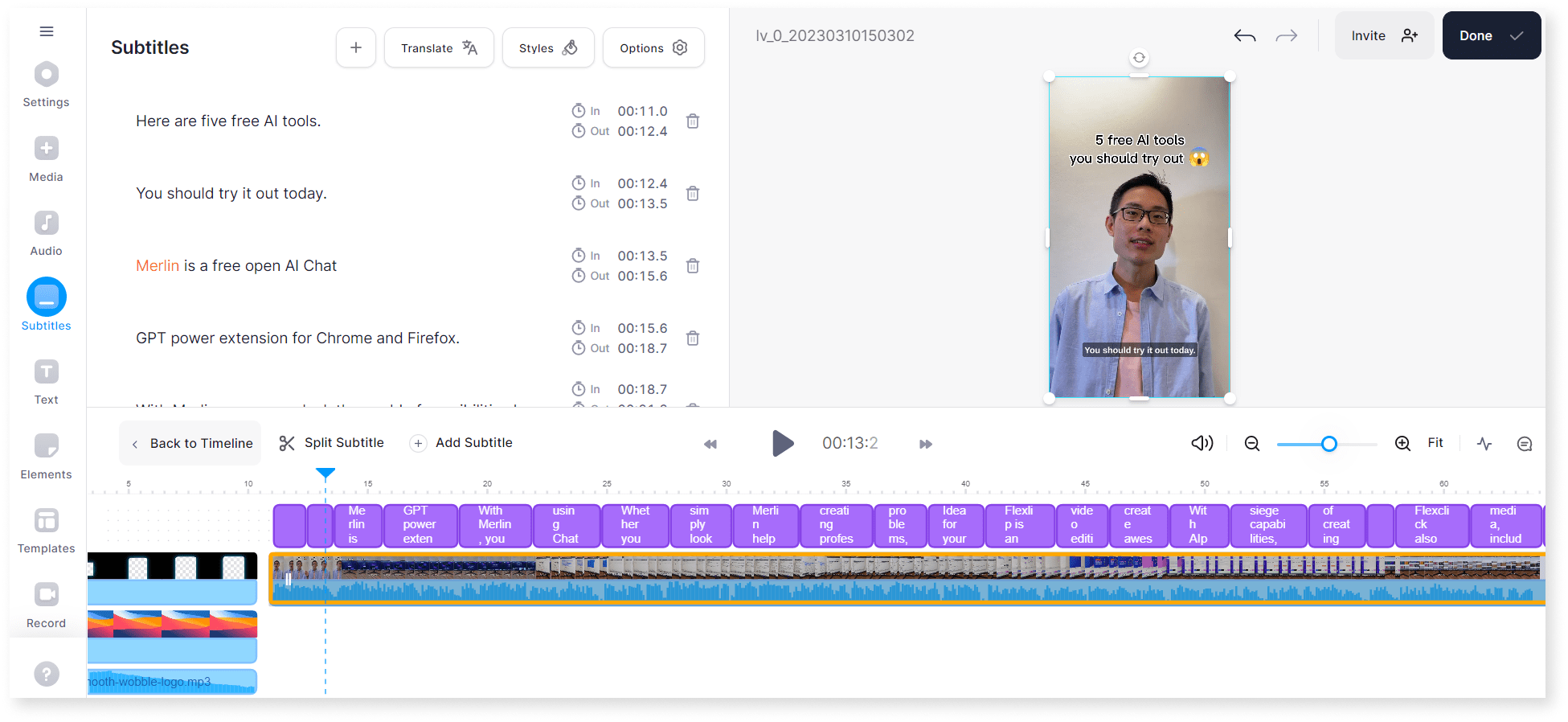
Promote Your Content
To be honest, I didn’t do well in promoting the high-converting content that I shared in the introduction part. Most conversions come from organic traffic, and I think it will certainly perform much better if I’ve promoted it aggressively.
Here is a collection of link building case studies you can learn from, showing real-world examples of effective content promotion strategies.
So to prevent you from making the same mistake, here are six effective ways to promote your high-converting content:
Repurpose Your Content on Social Media
Brendan Hufford, founder of Growth Sprints, once said that one of his content marketing philosophies is taking content work out of the silo.
He mentioned that if you have a series of excellent content that can help grow your business, such as content that helps to increase sales or expand your reach, you should create and repurpose them.
Although he didn’t mention the platforms, I think the most fundamental platform is social media. – not the platform you love but the platform your target audiences are actively using.
When I say “repurpose”, it doesn’t mean you just share your post and wait for people to click and read it. You need to understand the intentions of the users on that platform.
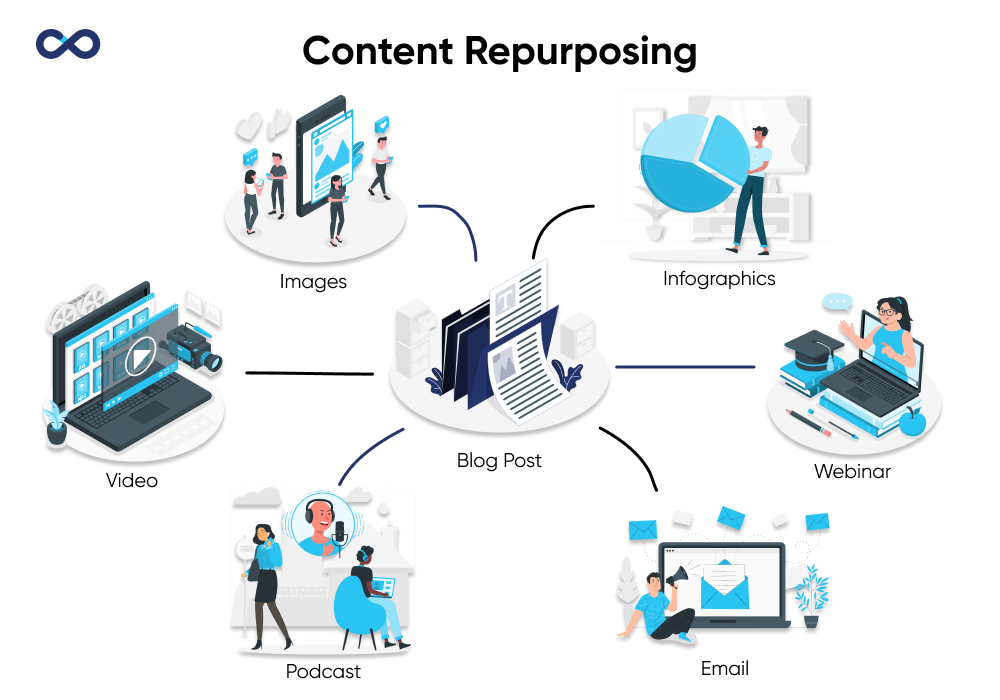
For instance, we found that Instagram can be a good platform to share new AI SEO tools and tips that help people work better, and since we’re an SEO agency, we think it’d be great to repurpose some of our content on social media. Not surprisingly, some of them perform very well.
View this post on Instagram
Blast It to Your Email Subscribers
Needless to say, email marketing is one of the best ways to drive conversions since your subscribers already have the intent to know more about your content, services or products.
To further leverage your results, you may want to consider sending your content to specific subscribers based on their behaviours and actions, such as their open rate, the type of content that resonates, etc. You will get more conversions if your content is highly specific and personalised.
Also, remember to ask for their feedback or opinions to know how your target audiences think and feel about your content.
Consider Social Media Paid Advertising
Social media ads are the fastest way to get more impressions and traffic. Research conducted by Benji and Devesh found that Facebook paid ads helped them get quick traffic while waiting for organic search results.
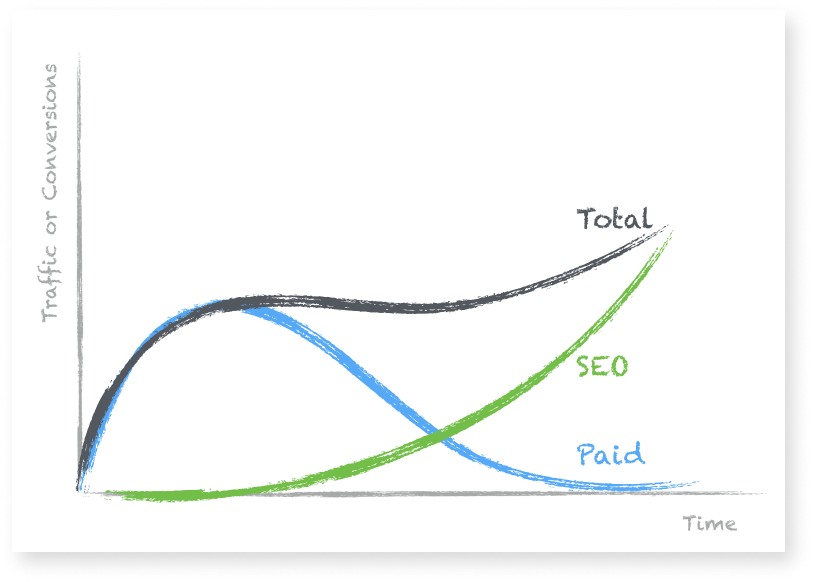
Partner with Influencers
We didn’t really try this out yet, but some case studies show that asking influencers in your industry to help you promote your content through their blogs, podcast or YouTube video is a powerful way to drive conversion to your content.
But before you reach out to them, ensure the influencer has the same that as your target customers, and carefully craft content that you know will resonate with them.
Track, Monitor and Improve Your Content
After your content is published, remember to track it to know how your content performs and what needs improvement.
In general, you should note:
- Click-through rate (CTR): To understand whether people want to read your content. If you have a low CTR, try to improve your headline by following these best practices.
- Engagement time/rate: A higher engagement time means people consume your content. Improve those with a lower engagement rate by referring to content with a higher engagement rate.
- Number of backlinks gain: If your content generates a lot of backlinks, it means that the topic is a topic that link creators are searching for.
- Social share: If your post gets a lot of shares on social media, then you might want to promote it further on that platform
- Conversion from the post: This is crucial as it helps to identify which content you should keep the best at all time
The most fundamental tool you should use is Google Analytics. It allows you to track most of the data in your content. You can even link to Google Looker Studio Report to help you filter out the crucial metrics you want to focus on.
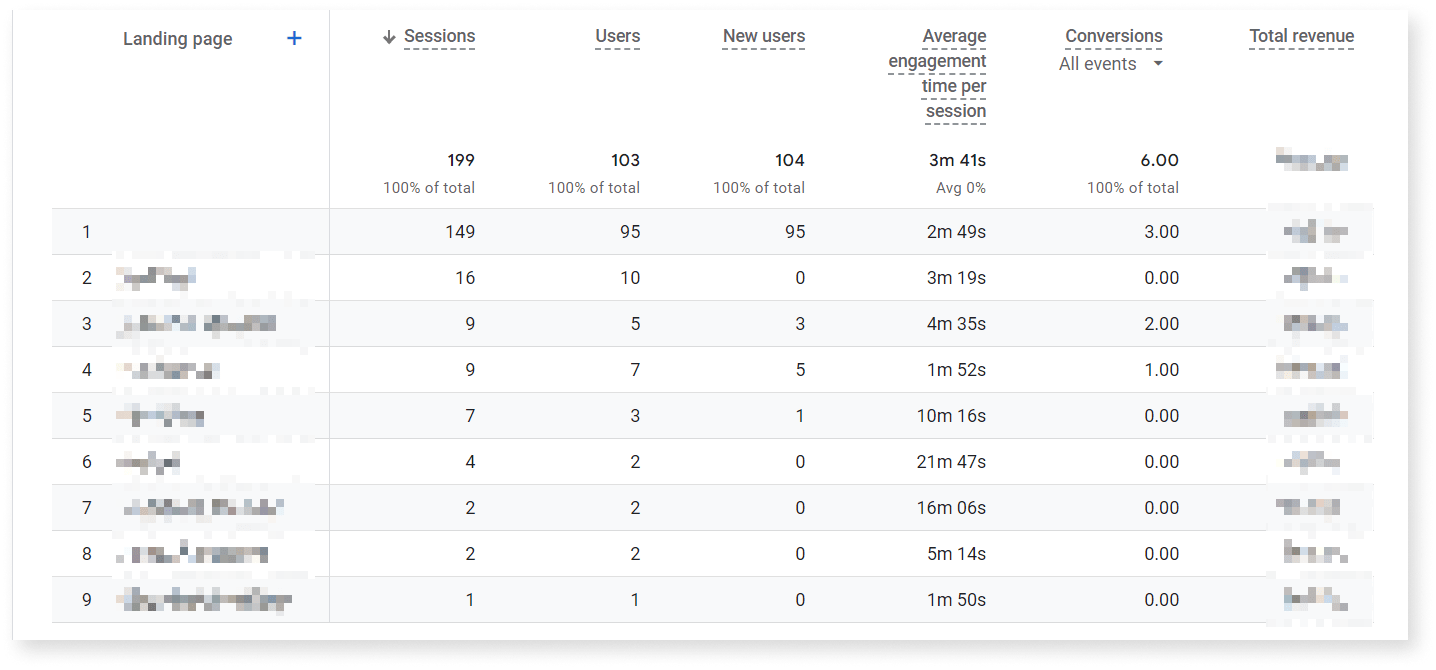
You can use other SEO tools to get more comprehensive data on how your content perform:
- Keyword position-tracking tools: Nightwatch or Pro Rank Tracker
- Social media performance: Content Studio
Don’t stress yourself too much if the content doesn’t perform well. Most of our content also did not perform well the first time. Give Google some time to test out the content.
Conclusion
In this era where anyone can generate tons of articles with the use of AI and keyword research tool, it’s going to be harder to stay ahead of the curve and stand out from your competitors.
Fortunately, you can still perform better than your competitors if your content not only brings traffic but generates leads and conversions that increase your revenue.
That’s why VeecoTech focus on content creation in our SEO services! We’re not just focusing on helping you to rank for plenty of keywords like most of the SEO agencies, but go deeper by crafting a content strategy that helps you to drive more conversions.
If you need help in your SEO, feel free to contact us for our SEO services today if you want to create content that generates leads and conversion continuously.


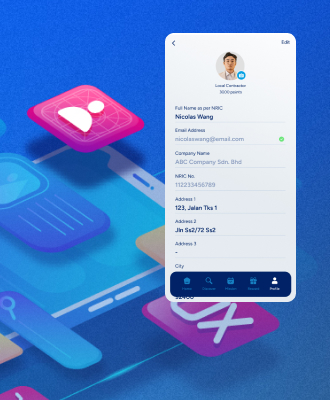

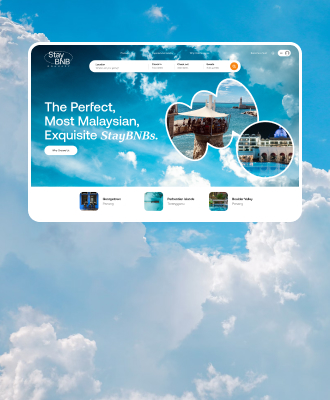
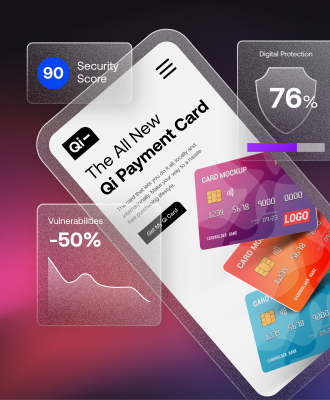
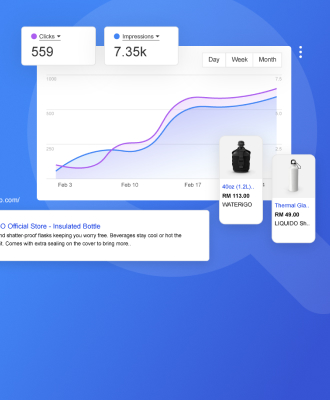
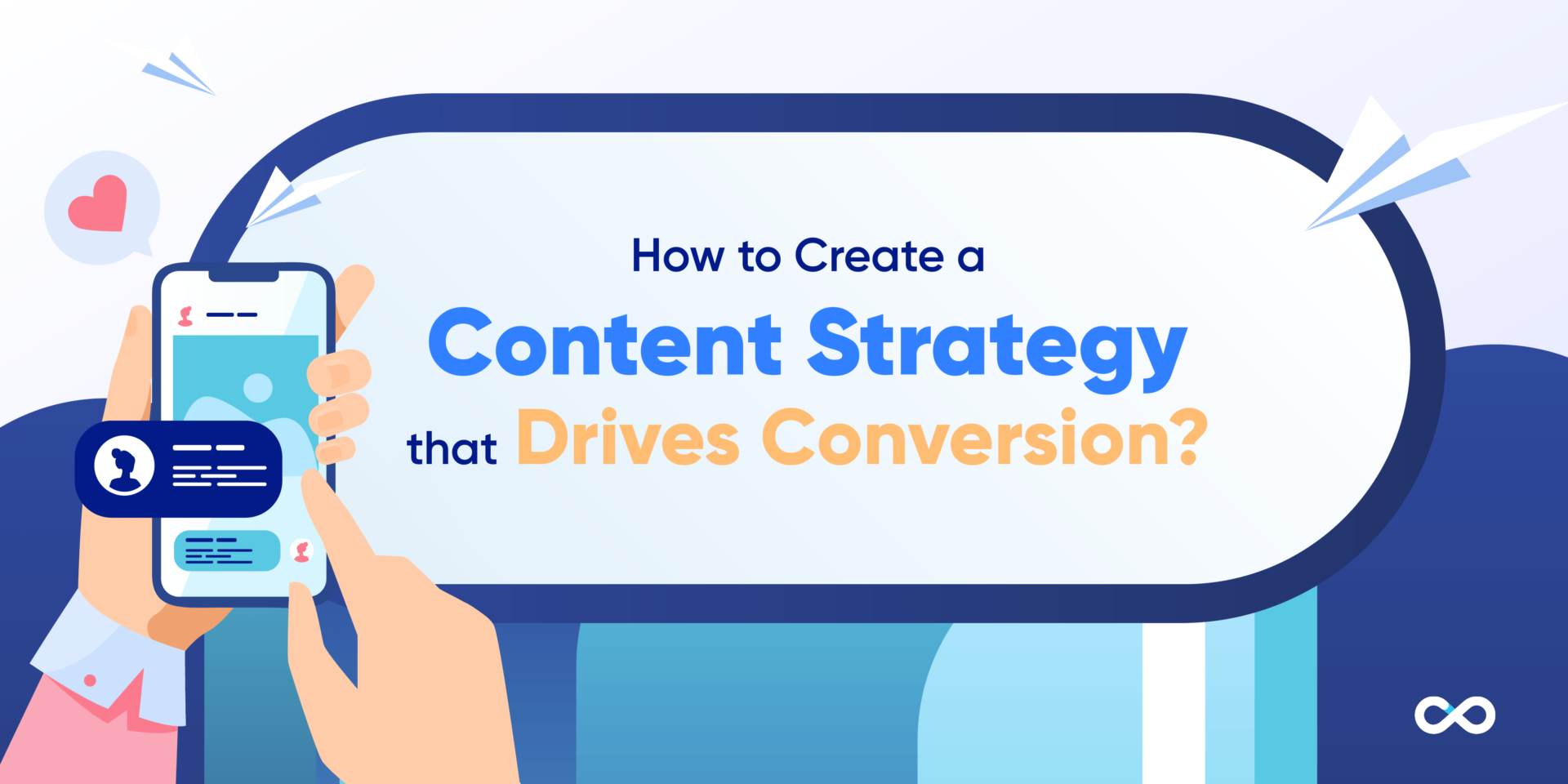
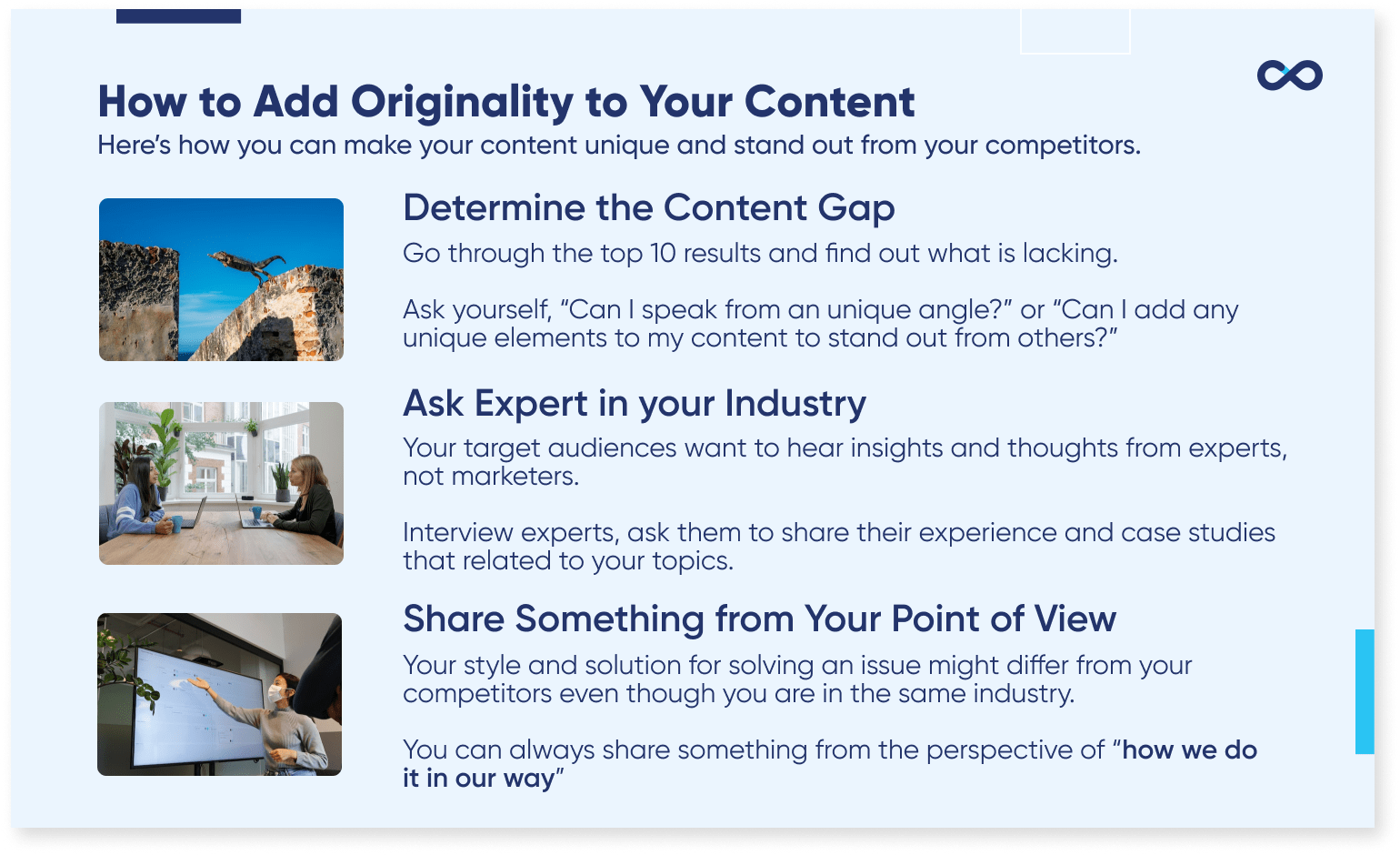

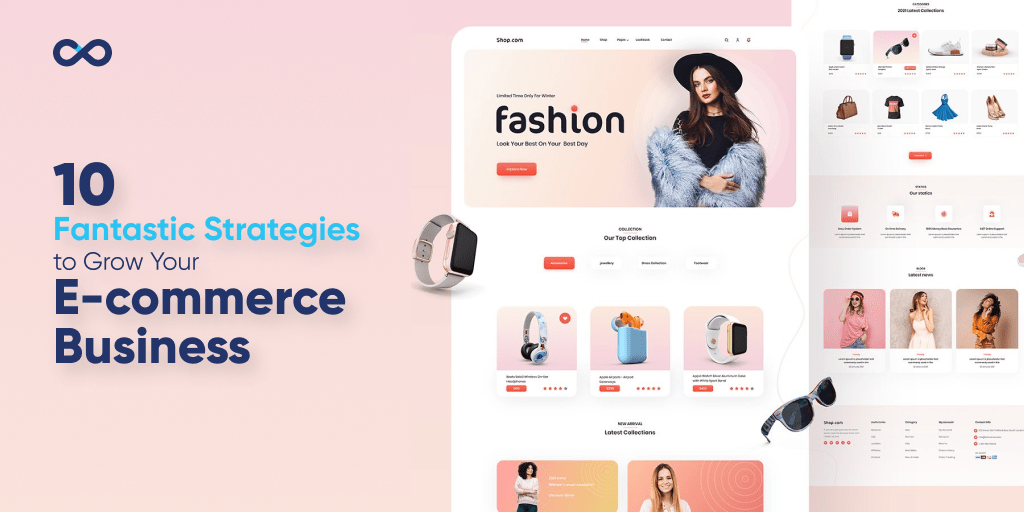



Leave A Comment